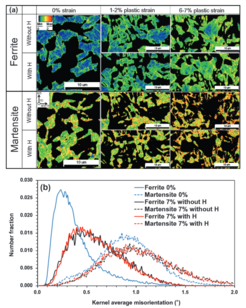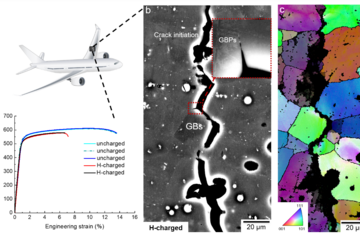Decohesion and localized plasticity in dual-phase steel due to hydrogen
Hydrogen embrittlement affects high-strength ferrite/martensite dual-phase (DP) steels. The associated micromechanisms which lead to failure have not been fully clarified yet. Here we present a quantitative micromechanical analysis of the microstructural damage phenomena in a model DP steel in the presence of hydrogen.

(a) KAM maps at different plastic strain levels with and without hydrogen charging. The ferrite and martensite were separated in terms of grain
average IQ value. (b) KAM value distribution of the specimen with and without hydrogen charging at 0% and 7% local plastic strains.
A high-resolution scanning electron microscopy-based damage quantification technique has been employed to identify strain regimes where damage nucleation and damage growth take place, both with and without hydrogen precharging. The mechanisms corresponding to these regimes have been investigated by employing post-mortem electron channeling contrast imaging and electron backscatter diffraction analyses, as well as additional in situ deformation experiments. The results reveal that damage nucleation mechanism (i.e. martensite decohesion) and the damage growth mechanisms (e.g. interface decohesion) are both promoted by hydrogen, while the crack-arresting capability of the ferrite is significantly reduced. The observations are discussed on the basis of the hydrogen-enhanced decohesion and hydrogen-enhanced localized plasticity mechanisms. We discuss corresponding microstructure design strategies for better hydrogen-related damage tolerance of DP steels.












